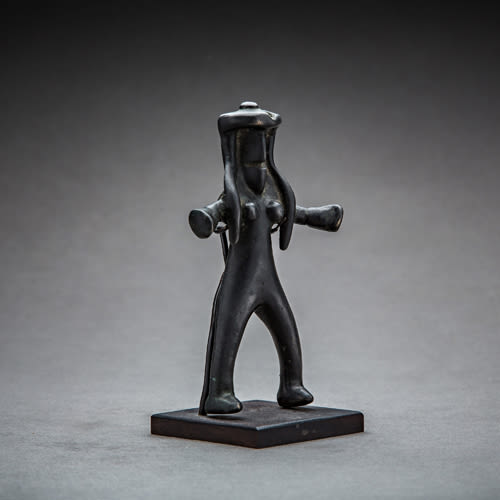Indus Valley Metal Alloy Fertility Goddess, 3500 BCE - 2000 BCE
Metal Alloy
14.5 x 6.9 cm
5 3/4 x 2 3/4 in
5 3/4 x 2 3/4 in
LO.1419
This metal alloy statue depicting the Fertility Goddess is a rare survivor of the Indus Valley civilization before the second millennium BCE. The Indus Valley Civilization utilized various metals including...
This metal alloy statue depicting the Fertility Goddess is a rare survivor of the Indus Valley civilization before the second millennium BCE. The Indus Valley Civilization utilized various metals including copper, bronze, gold, silver, and lead for a wide range of purposes. They were skilled in metallurgy, crafting tools, weapons, ornaments, and household items from these metals. The female figure has a slender physique, prominent breasts, and hair that extends below the shoulders. She wears a small circular crown-like fitting atop her head, has deep eye sockets and an incised mouth. The symmetry of the woman figure depicting the Fertility Goddess is mirrored in standing female clay figurines from this period .
The Indus Valley civilization was rediscovered in 1920-21 when engraved seals were unearthed in the Punjab province of Pakistan at a site called Harappa, a name which is often used to describe the civilization as a whole. Subsequent excavations at Harappa revealed the size and complexity of this ancient city. Other sites were unearthed as well along the banks of the Indus River, including the equally large city of Mohenjodaro. Through archaeological and historical research, we can now say for certain that a highly developed urban civilization flourished in the Indian subcontinent over five thousand years ago. Though the Indus Valley script remains undeciphered, the numerous seals, statuary, and pottery discovered during excavations, not to mention the urban ruins, have enabled scholars to construct a reasonably plausible account of the Indus Valley civilization.
Some kind of centralized state, and certainly fairly extensive town planning, is suggested by the layout of the great cities of Harappa and Mohenjodaro. The same kind of burnt brick appears to have been used in the construction of buildings in cities that were several hundred miles apart. The weights and measures also show a very considerable regularity, suggesting that these disparate cities spread out across a vast desert shared a common culture. The Indus Valley people domesticated animals, and harvested various crops, such as cotton, sesame, peas, barley, and cotton. Indus Valley seals have been excavated in far away cities such as Sumer, suggesting that a wealthy merchant class existed, engaged in extensive trading throughout the subcontinent and the Near East.
Considering the size of this civilization, it is puzzling that no monumental art remains, glorifying the names of the powerful rulers or wealthy merchants who could have afforded to construct such memorials. Instead, we find an emphasis on small, elegant art and sophisticated craft technology. Three-dimensional representations of living beings in the Harappan world are confined to, with a few exceptions, small terracotta figurings. Ranging in size from a few inches to a foot in height, the anthropomorphic and animal terracotta figurines from Harappa and other Indus Civilization sites offer a rich reflection of Harappan life in the Bronze Age. Traditionally, the terracotta figurines have been described as toys. Other objects such as carts, wheels, and cots discovered alongside the figurines has only reinforced this notion. However, whether these figures were idols meant to be worshipped or merely charming representations of daily life meant to entertain children remains debatable.
The Indus Valley civilization was rediscovered in 1920-21 when engraved seals were unearthed in the Punjab province of Pakistan at a site called Harappa, a name which is often used to describe the civilization as a whole. Subsequent excavations at Harappa revealed the size and complexity of this ancient city. Other sites were unearthed as well along the banks of the Indus River, including the equally large city of Mohenjodaro. Through archaeological and historical research, we can now say for certain that a highly developed urban civilization flourished in the Indian subcontinent over five thousand years ago. Though the Indus Valley script remains undeciphered, the numerous seals, statuary, and pottery discovered during excavations, not to mention the urban ruins, have enabled scholars to construct a reasonably plausible account of the Indus Valley civilization.
Some kind of centralized state, and certainly fairly extensive town planning, is suggested by the layout of the great cities of Harappa and Mohenjodaro. The same kind of burnt brick appears to have been used in the construction of buildings in cities that were several hundred miles apart. The weights and measures also show a very considerable regularity, suggesting that these disparate cities spread out across a vast desert shared a common culture. The Indus Valley people domesticated animals, and harvested various crops, such as cotton, sesame, peas, barley, and cotton. Indus Valley seals have been excavated in far away cities such as Sumer, suggesting that a wealthy merchant class existed, engaged in extensive trading throughout the subcontinent and the Near East.
Considering the size of this civilization, it is puzzling that no monumental art remains, glorifying the names of the powerful rulers or wealthy merchants who could have afforded to construct such memorials. Instead, we find an emphasis on small, elegant art and sophisticated craft technology. Three-dimensional representations of living beings in the Harappan world are confined to, with a few exceptions, small terracotta figurings. Ranging in size from a few inches to a foot in height, the anthropomorphic and animal terracotta figurines from Harappa and other Indus Civilization sites offer a rich reflection of Harappan life in the Bronze Age. Traditionally, the terracotta figurines have been described as toys. Other objects such as carts, wheels, and cots discovered alongside the figurines has only reinforced this notion. However, whether these figures were idols meant to be worshipped or merely charming representations of daily life meant to entertain children remains debatable.
1
of
171



